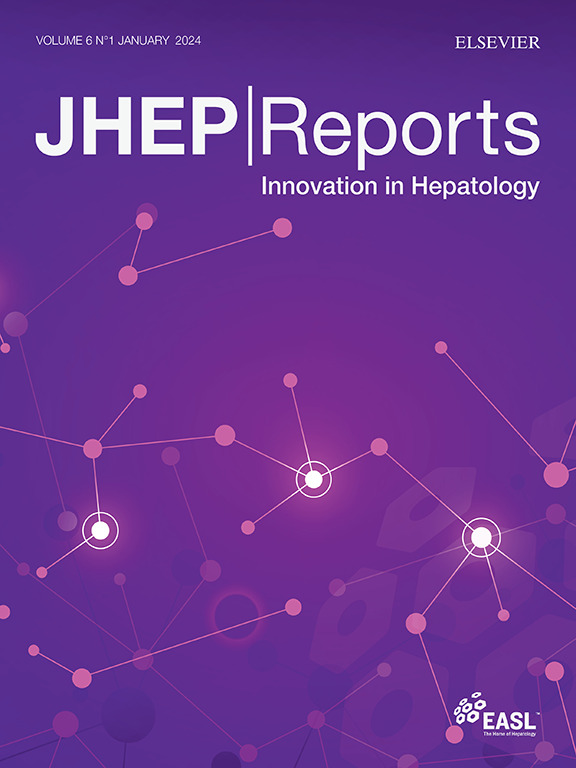模拟肝脏在不同临床条件下的再生能力
IF 7.5
1区 医学
Q1 GASTROENTEROLOGY & HEPATOLOGY
引用次数: 0
摘要
背景,AimsLiver再生对于损伤后的恢复至关重要,但这一过程可能受到性别、年龄、代谢紊乱、纤维化和免疫抑制疗法等因素的影响。我们的目标是利用系统生物学和机器学习方法,在这些不同条件下的小鼠模型中识别关键的转录组学、蛋白质组学和血清生物标志物。方法6只小鼠模型,每只接受75%的肝切除术,用于研究不同临床背景下的再生:年轻雄性和雌性,老年小鼠,2期纤维化,脂肪变性和他克莫司暴露。开发了一种新的具有三重态损失的对比深度学习框架,用于绘制再生轨迹并识别与再生效率相关的基因。结果:尽管在第7天实现了≥75%的肝块修复,但在衰老、脂肪变性和纤维化模型中,再生明显延迟,第2天Ki-67染色降低(p <0.0001)。有趣的是,肝切除术后纤维化肝表现出胶原沉积减少和部分回归到1期纤维化。转录组学和蛋白质组学分析显示,再生受损的细胞周期基因一致下调。整合临床和转录组学数据的深度学习模型预测再生结果的准确率为87.9%。SHAP (SHapley Additive exPlanations)强调了六个关键的预测基因:Wee1、Rbl1、Gnl3、Mdm2、Cdk2和Ccne2。蛋白质组学验证和人类SPLiT-seq(基于分裂池连接的转录组测序)数据进一步支持了它们在物种间的相关性。本研究确定了有效肝脏再生的保守细胞周期调节因子,并为评估再生能力提供了预测框架。深度学习和多组学分析的整合为更好地理解肝脏再生提供了一种有前途的方法,并可能有助于指导治疗策略,特别是在复杂的临床环境中。影响和启示本研究的目的是利用系统生物学和机器学习方法,确定不同条件下小鼠模型中再生的关键转录组学、蛋白质组学和血清生物标志物。利用创新的深度学习和多组学方法,确定了不同临床条件下肝脏再生的关键分子驱动因素。通过鉴定预测再生结果的保守细胞周期基因,本研究提供了一个强大的框架来评估和潜在地增强老年患者、纤维化或脂肪变性患者和/或免疫抑制患者的肝脏恢复。本文章由计算机程序翻译,如有差异,请以英文原文为准。

Modelling the liver’s regenerative capacity across different clinical conditions
Background & Aims
Liver regeneration is essential for recovery following injury, but this process can be impaired by factors such as sex, age, metabolic disorders, fibrosis, and immunosuppressive therapies. We aimed to identify key transcriptomic, proteomic, and serum biomarkers of regeneration in mouse models under these diverse conditions using systems biology and machine learning approaches.
Methods
Six mouse models, each undergoing 75% hepatectomy, were used to study regeneration across distinct clinical contexts: young males and females, aged mice, stage 2 fibrosis, steatosis, and tacrolimus exposure. A novel contrastive deep learning framework with triplet loss was developed to map regenerative trajectories and identify genes associated with regenerative efficiency.
Results
Despite achieving ≥75% liver mass restoration by day 7, regeneration was significantly delayed in aged, steatotic, and fibrotic models, as indicated by reduced Ki-67 staining on day 2 (p <0.0001 for all). Interestingly, fibrotic livers exhibited reduced collagen deposition and partial regression to stage 1 fibrosis post-hepatectomy. Transcriptomic and proteomic analyses revealed consistent downregulation of cell cycle genes in impaired regeneration. The deep learning model integrating clinical and transcriptomic data predicted regenerative outcomes with 87.9% accuracy. SHAP (SHapley Additive exPlanations) highlighted six key predictive genes: Wee1, Rbl1, Gnl3, Mdm2, Cdk2, and Ccne2. Proteomic validation and human SPLiT-seq (split-pool ligation-based transcriptome sequencing) data further supported their relevance across species.
Conclusions
This study identifies conserved cell cycle regulators underlying efficient liver regeneration and provides a predictive framework for evaluating regenerative capacity. The integration of deep learning and multi-omics profiling provides a promising approach to better understand liver regeneration and may help guide therapeutic strategies, especially in complex clinical settings.
Impact and implications
The aim of this study was to identify key transcriptomic, proteomic, and serum biomarkers of regeneration in mouse models under diverse conditions, using systems biology and machine learning approaches. Key molecular drivers of liver regeneration across diverse clinical conditions were identified using innovative deep learning and multi-omics approaches. By identifying conserved cell cycle genes predictive of regenerative outcomes, this study offers a powerful framework to assess and potentially enhance liver recovery in older patients, those with fibrosis or steatosis, and/or those under immunosuppression.
求助全文
通过发布文献求助,成功后即可免费获取论文全文。
去求助
来源期刊

JHEP Reports
GASTROENTEROLOGY & HEPATOLOGY-
CiteScore
12.40
自引率
2.40%
发文量
161
审稿时长
36 days
期刊介绍:
JHEP Reports is an open access journal that is affiliated with the European Association for the Study of the Liver (EASL). It serves as a companion journal to the highly respected Journal of Hepatology.
The primary objective of JHEP Reports is to publish original papers and reviews that contribute to the advancement of knowledge in the field of liver diseases. The journal covers a wide range of topics, including basic, translational, and clinical research. It also focuses on global issues in hepatology, with particular emphasis on areas such as clinical trials, novel diagnostics, precision medicine and therapeutics, cancer research, cellular and molecular studies, artificial intelligence, microbiome research, epidemiology, and cutting-edge technologies.
In summary, JHEP Reports is dedicated to promoting scientific discoveries and innovations in liver diseases through the publication of high-quality research papers and reviews covering various aspects of hepatology.
 求助内容:
求助内容: 应助结果提醒方式:
应助结果提醒方式:


